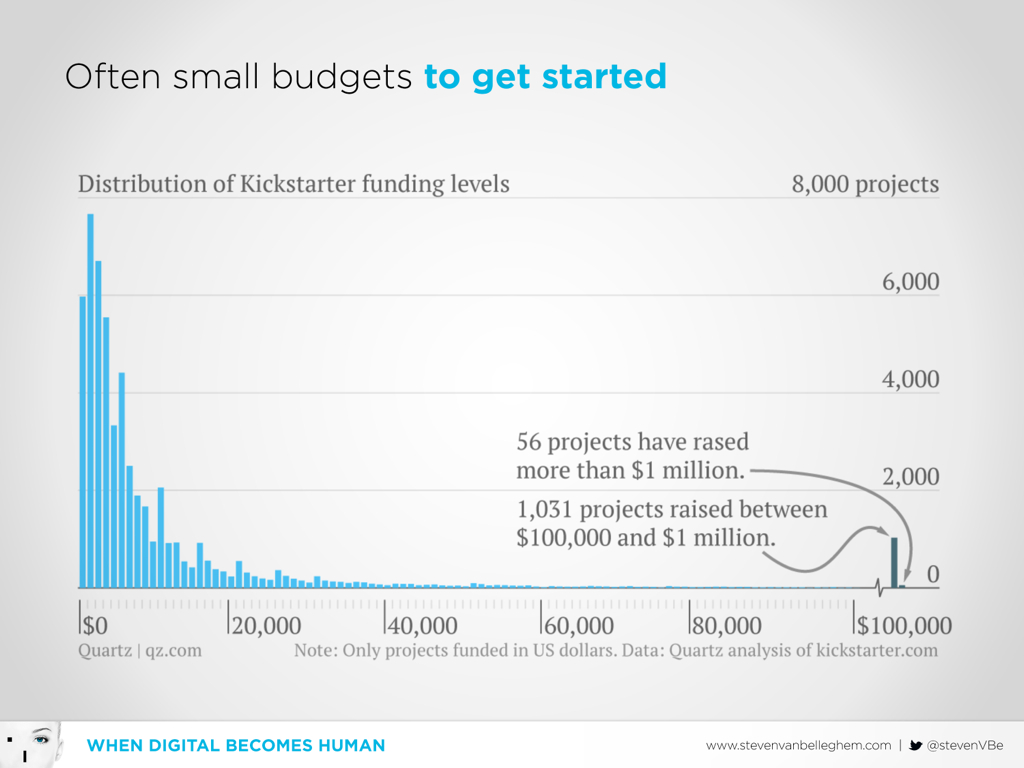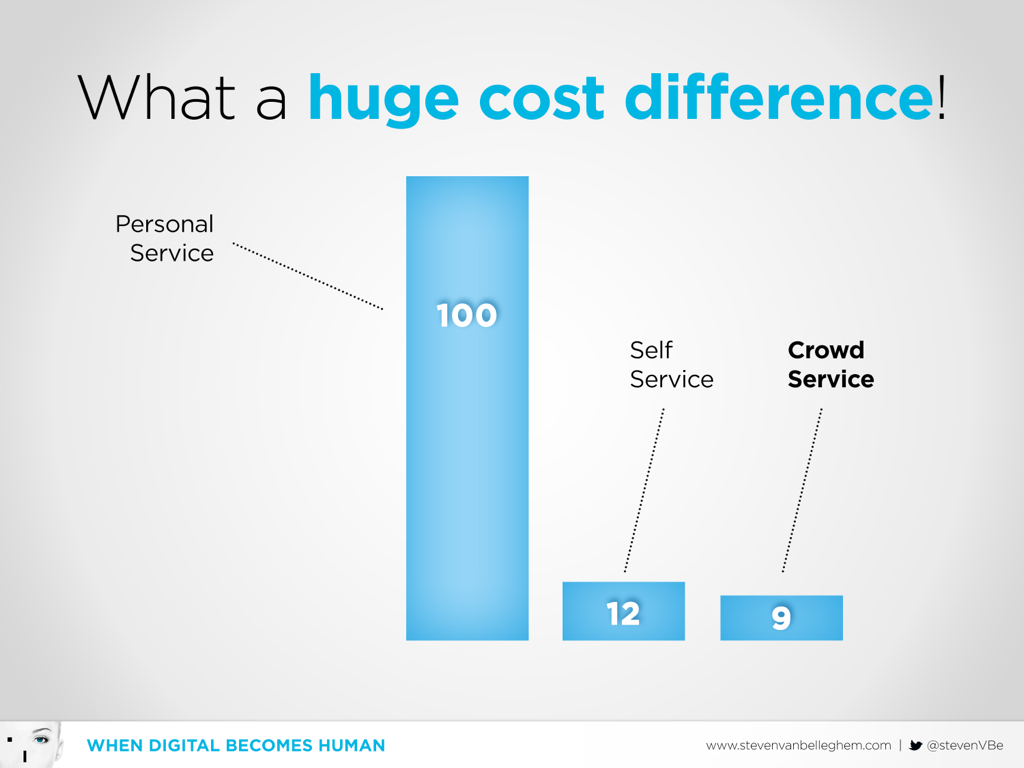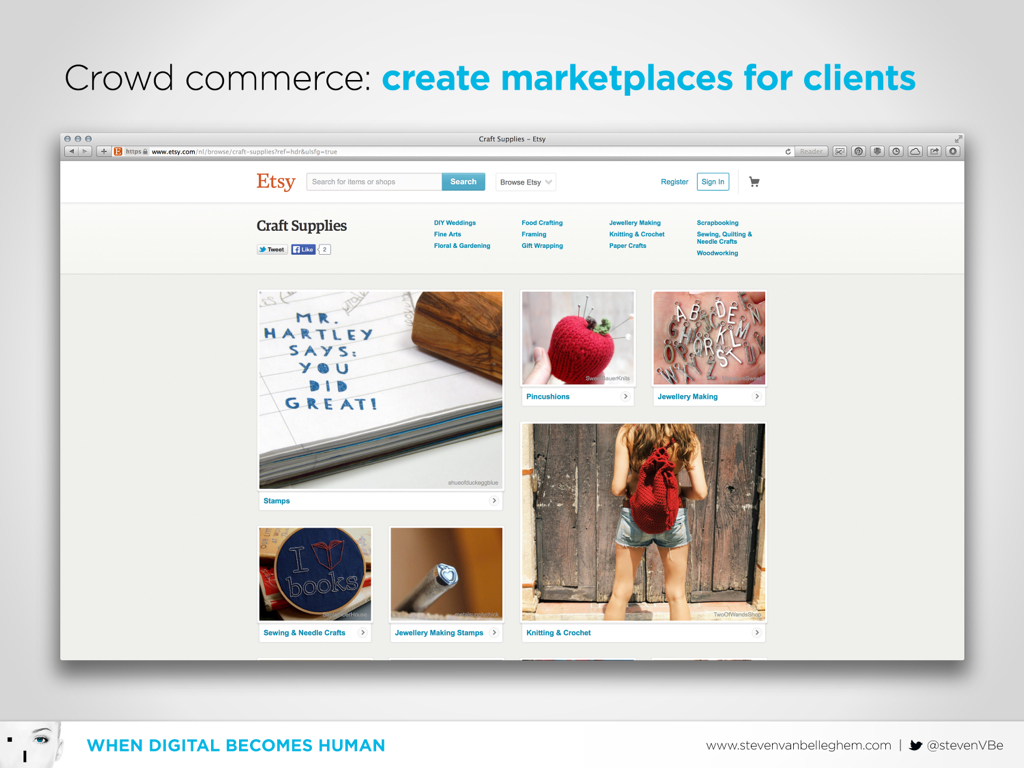How the collaborative economy is creating a human touch in a customer relation

1. Crowd sourcing
The market is potentially a tremendous source of inspiration for organizations. By appealing to their customers for help, it is possible to find new products, meet short-term deadlines and implement improvements in relational processes. In ‘The Conversation Company’ I described the customer as the best consultant for any company. In ‘The Consumer Consulting Board‘ InSites Consulting explores this thinking further. More and more companies are discovering the added value of developing a community of customer-advisers. It is extremely useful for any organization to be able to test its day-to-day decisions against the opinions of its own customers. Many major brands now have customer communities of this kind. Some of these communities operate behind the scenes; some of them are open innovation platforms. Adidas started its customer community in 2012 and the Adidas Insiders are now a daily source of inspiration for the brand. In 2013 Procter & Gamble also launched an open innovation website to capitalize on this trend. The input of consumers is necessary both to generate new ideas and to test them, once developed. The customers who take part in these platforms become even more committed to the brand. It strengthens the customer relationship immeasurably.
Crowd sourcing can go much further than the collection of new ideas relating to products and customer service. Companies can also make use of the crowd to help in the effective development of these ideas. This was the approach adopted by Cartamundi for an important pitch. When the first design suggestions were not favorably received by a key customer, the company decided it needed to inject some extra creativity into its proposals. They decided to share their conceptual ideas with a community of designers. Within 24 hours they had received offers from five designers to further expand and elaborate the basic concept. These designers came from all over the world (including Colombia, India and Mexico). Cartamundi then organized a poll amongst the wider community to see which of the five new ideas was thought to be the best. The winner was awarded 500 dollars for his work; the other four were given a lesser amount. The end result was that within 24 hours Cartamundi was able to resubmit its proposals to its key customer, but at a much higher level – and this time with success. This case highlights the benefits that crowd sourcing can offer: increased flexibility, lower costs and more satisfied customers.
2. Crowd funding
If you think of Jamaica, you probably think, like most people, of reggae music, palm trees and rum. You probably don’t think about snow and ice. Even so, in 1988 Jamaica took part in the Winter Olympics for the first time ever with its very own bobsleigh team. For the 2014 Olympic Games in Sochi, the Jamaicans once again qualified with their bobsleighers. Unfortunately, this time there was not enough money to fund the team’s journey to and stay in Russia. And so they decided to turn to crowd funding. They explained their needs online and launched an appeal for the necessary 80,000 dollars. Within days, they had reached their target. Thank to a group of total strangers, they were able to make their dream of participating in the Olympics come true.
Crowd funding has increased considerably in popularity in recent years. The largest crowd funding platform in the world is Kickstarter. Between the launch of the platform in 2009 and mid-2014, it had raised approximately 1.2 billion dollars of funding for more than 65,000 projects. In total, 6.5 million people from all around the world have made contributions at one time or another; 2 million of these invest regularly in the site’s new concepts. This idea of turning to ordinary members of the public for funding instead of to major investors and venture capitalists has now become an important financial alternative for start-ups that need a relatively small initial budget. Crowd funding is less common (and less successful) when large budgets are required. Only 56 Kickstarter projects have raised more than 1 million dollars. Around 1,000 projects have raised between 100,000 dollars and 1 million dollars. The vast majority of projects have to be satisfied with 20,000 dollars or less.
Crowd funding offers excellent opportunities to tie the interested part of the market more closely to individual companies. Because people have committed themselves financially, they are also more inclined to commit themselves emotionally. They follow up ‘their’ projects much more closely and serve as excellent PR ambassadors. What’s more, crowd funding is not only the preserve of small companies and start-ups.
3. Crowd service
In 2010 T-Mobile in the Netherlands woke up to find itself in the middle of a PR crisis about its lack of customer orientation. A well-known Dutch cabaret artist, Youp Van ’t Hek, had taken the company to task for the continual bad service he had received. Since then, T-Mobile has made considerable progress. 95% of all service queries within T-Mobile are now self-service. Any remaining questions are largely dealt with via crowd service. T-Mobile has the largest customer forum in the Netherlands, with some 193,000 users in 2014. In the forum, customers and T-Mobile staff help each other to improve the company’s service. 65% of all customer (non-self-service) questions are now answered by other customers, usually within minutes and nearly always with the correct information. In the past, some 20% of customer questions were received by telephone. Thanks to self-service and crowd service, this figure has now been reduced to just 1.5%. Customer satisfaction over both channels currently stands at more than 8.5 out of 10.
Crowd service can have numerous advantages for almost any company. The cost benefits of crowd service compared to personal service are huge. This is what McKinsey calculated: if personal service costs 100, then self-service costs 12 and crowd control just 9. This is another form of the return on happiness: more satisfied customers at a lower cost. But this time there is also an important additional benefit: it adds a human aspect to the customer relationship by bringing customers into contact with each other.
4. Crowd commerce
The fourth possibility to involve the crowd in your activities is to create a marketplace where your customers can do business with each other. The Amazon site for second-hand goods is an excellent example. Amazon’s core business is to sell new products to people, but they are also shrewd enough to see the benefits of helping people to sell their second-hand goods to others – so that they can buy more new ones from Amazon! Etsy is another good example of a marketplace where people can sell homemade and handmade products to each other.
Marketplaces of this kind are very popular with consumers. AirBnB, Lending Club and eBay are amongst the most well-known. They are digital platforms where ordinary people can sell things to each other. But it is also interesting for individual companies to try and set up a marketplace of this kind. It brings your customers together – always a good thing from an emotional perspective – and it can also result in extra business. Not so long ago, Patagonia launched ‘Worn Wear’, a platform to give used clothes a new lease of life. The company buys back second-hand clothes from its customer and then sells them on e-bay at knock-down prices.
Human connections as the ultimate human component in the customer relationship
Bringing people together who share a common interest always creates a pleasant atmosphere. If you know a cafe with a fun public, it is probably your favorite café – and the favorite café of many others as well. If the owner of this café is creative, empathic and passionate, he can probably turn the place into a goldmine. These are the elements you need to create the perfect human relationship. You build this relationship through a series of human interactions. However, the number of human interactions in the customer-company relationship is steadily falling, and will continue to do so. But if a company can increase the number of its customer to customer interactions, this will boost the human element in its overall customer relationship process in an efficient and effective manner.
Crowd sourcing and crowd funding both have the potential to connect consumers and companies in an intense way. The consumers contribute meaningfully to the company either through their organizational help or by their financial support. This form of commitment is important in strengthening the emotional relationship. Crowd service and crowd commerce build added value for consumers by allowing them to help each other or to do business with each other. A strong bond between customers also results in a strong bond with the platform that makes this customer interaction possible. Twitter and Facebook generate no content of their own, but still occupy an important place in the lives of many people. Why? Because they bring people together, to the benefit of the people concerned but also to the (huge) benefit of the platform. Thinking how your customers can best create value for each other is the final step on the pathway that will lead you towards the best possible customer relationship for the future.



